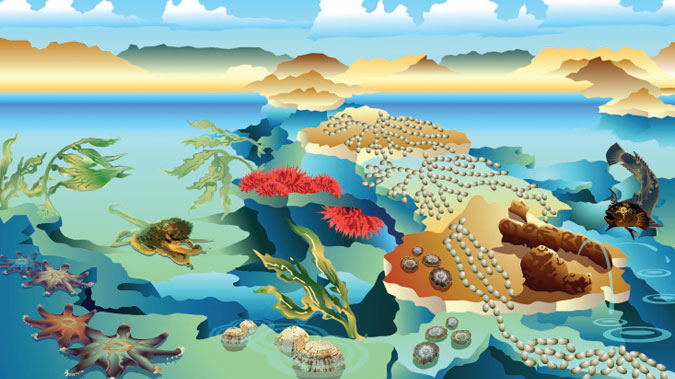Rocky Reefs poster

Victoria's Rocky Reefs are fascinating habitats that are rich in life. Rocky reefs provide a habitat for many marine animals and seaweeds which need to attach themselves to something solid for their survival. While we do not have reef building corals in Victoria many of our rocky reefs are covered in brightly coloured animals and seaweeds.
Reefs are found where rocks occur above or below the waterline. As the rocks are eroded by the action of water, cracks and holes appear which increase the availability of shelter for living things. Different rock types weather in different ways creating spectacular formations that can support different species.
Below the low tide mark rocky reefs can support extensive communities of marine plants which may include kelp forests. Reefs that are hidden from sunlight in deeper water, or under ledges, often have brightly coloured communities of invertebrates, many of which rival coral reefs for colour and diversity. Rocky reefs that are exposed at low tide are great places to explore as there are many animals and some seaweeds that can survive out of the water for some time.
Rocky reefs are also important because they provide habitat for many species of fish and other animals, including two of our most commercially viable species, the rock lobster and the abalone.
Key Species

Neptune's Necklace
(Hormosira banksii)
Neptune's necklace is a common brown seaweed that grows attached to rocks on exposed and sheltered rocky reefs. It forms dense yellow to brown mats covering the rock platform. The bead like segments are filled with water allowing
this plant to survive out of the water between high tides.

Waratah Anemone
(Actinia tenebrosa)
Appearing as jelly-like blobs out of water, these predators extend beautiful red tentacles into the water when covered by the tide. When prey swim into the tentacles, harpoon like darts delivering paralysing poisons are released.
These stinging animals are relatives of corals & sea jellies.

Smooth Limpet
(Cellana tramoserica)
Growing up to 50mm long these limpets graze on microalgae growing on rock surfaces and are responsible for keeping large areas of rock bare by grazing on young seaweeds. Limpets possess a strong muscular foot to secure them to the
rock surface and protect them from being removed by waves or predators.

Tasmanian Blenny
(Parablennius tasmanianus)Living in rock crevices, empty shells or even discarded bottles, is the brownish to blue-grey mottled Tasmanian blenny. This small territorial fish is characterised by two long frilly tentacles over the eyes. During the spawning
season females guard clusters of eggs attached to the sides of their nests.

Bull Kelp
(Durvillaea potatorum)
Common at the low tide mark on exposed rocky coasts are the massive bull kelp typical of cool water environments. Growing up to 10m long they have thick leathery leaves (fronds) and cup shaped 'holdfasts' that anchor them to the rock.
Gel like chemicals within fronds are extracted for use in processed foods.

Sea Squirt or Cunjevoi
(Pyura stolonifera)
These animals live fixed to the rock surface at the low tide zone where they filter food from water. One siphon draws water in while squirting excess out the other. Larval cunjevoi look like small tadpoles, and float as plankton
before sticking to rock surfaces and taking on their adult shape.

Common Seastar
(Patiriella calcar)
Visitors to the rocky shore will have seen these relatively common seastars. Although common in name, they are definitely not common in appearance, with amazing colour combinations of pinks, reds, browns, purples, greens and oranges.
These seastars are omnivores, feeding on algae and detritus, but will also eat other animals such as mussels.

Maori Octopus
(Octopus maorum)
This is the largest octopus in southern Australia and can grow to over 1.2 metres in length. Often seen in the early morning or evening, these large predatory animals seek out crustaceans with their long tentacles. Octopus have a sharp
beak within their tentacles to bite through crab shells and deliver a dose of poison.
Habitat Close Up
Sponge Gardens
Sheltered under rock platforms, within crevices and caves or in deeper waters with little light, live a diverse group of animals called sponges. These animals create a brilliant mosaic of colour and intricate patterns that make Victoria's marine environments as spectacular as the more familiar coral reefs.
Sponges are actually colonies of animals cooperating closely to feed and reproduce while remaining attached to something solid such as rocky reefs. The competition for limited space on the rock surface results in a wide diversity of interesting shapes, structures and sizes. Some sponges may be free standing while others form a thin layer covering the surface of rocky reefs.
Sponges are filter feeders that strain food directly from the water taken in through openings on their body surfaces.
Some sponges have developed chemical defences producing toxic slime that deters predators and prevents other organisms growing on them. Other sponges contain sharp glassy spines to deter unwelcome carnivores. Despite these defences, there are a few animals that feed on sponges, such as the biscuit star and spectacular slug-like nudibranchs.
Free swimming fish, octopus and cuttlefish hunt for prey in the gardens of sponges on rocky reefs adding to the mix of colours in these environments.
For more information or to visit some of these magnificent marine habitats, please contact the:
Marine and Freshwater Discovery Centre, Queenscliff
Ph: 03 5258 3344
Email: marine.discovery@vfa.vic.gov.au
